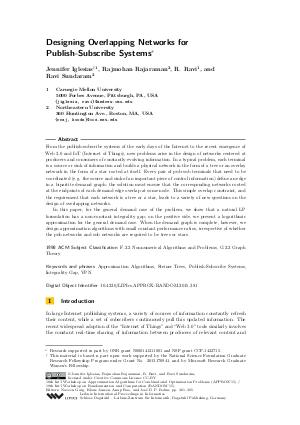Designing Overlapping Networks for Publish-Subscribe Systems
Authors Jennifer Iglesias, Rajmohan Rajaraman, R. Ravi, Ravi Sundaram
-
Part of:
Volume:
Approximation, Randomization, and Combinatorial Optimization. Algorithms and Techniques (APPROX/RANDOM 2015)
Part of: Series: Leibniz International Proceedings in Informatics (LIPIcs)
Part of: Conference: International Conference on Randomization and Computation (RANDOM)
Part of: Conference: International Conference on Approximation Algorithms for Combinatorial Optimization Problems (APPROX) - License:
 Creative Commons Attribution 3.0 Unported license
Creative Commons Attribution 3.0 Unported license
- Publication Date: 2015-08-13
File

PDF
LIPIcs.APPROX-RANDOM.2015.381.pdf
- Filesize: 0.51 MB
- 15 pages
Document Identifiers
Subject Classification
Keywords
- Approximation Algorithms
- Steiner Trees
- Publish-Subscribe Systems
- Integrality Gap
- VPN.
Metrics
- Access Statistics
-
Total Accesses (updated on a weekly basis)
0Document
0Metadata
Abstract
From the publish-subscribe systems of the early days of the Internet to the recent emergence of Web 3.0 and IoT (Internet of Things), new problems arise in the design of networks centered at producers and consumers of constantly evolving information. In a typical problem, each terminal is a source or sink of information and builds a physical network in the form of a tree or an overlay network in the form of a star rooted at itself. Every pair of pub-sub terminals that need to be coordinated (e.g. the source and sink of an important piece of control information) define an edge in a bipartite demand graph; the solution must ensure that the corresponding networks rooted at the endpoints of each demand edge overlap at some node. This simple overlap constraint, and the requirement that each network is a tree or a star, leads to a variety of new questions on the design of overlapping networks. In this paper, for the general demand case of the problem, we show that a natural LP formulation has a non-constant integrality gap; on the positive side, we present a logarithmic approximation for the general demand case. When the demand graph is complete, however, we design approximation algorithms with small constant performance ratios, irrespective of whether the pub networks and sub networks are required to be trees or stars.
Cite As Get BibTex
Jennifer Iglesias, Rajmohan Rajaraman, R. Ravi, and Ravi Sundaram. Designing Overlapping Networks for Publish-Subscribe Systems. In Approximation, Randomization, and Combinatorial Optimization. Algorithms and Techniques (APPROX/RANDOM 2015). Leibniz International Proceedings in Informatics (LIPIcs), Volume 40, pp. 381-395, Schloss Dagstuhl – Leibniz-Zentrum für Informatik (2015)
https://doi.org/10.4230/LIPIcs.APPROX-RANDOM.2015.381
BibTex
@InProceedings{iglesias_et_al:LIPIcs.APPROX-RANDOM.2015.381,
author = {Iglesias, Jennifer and Rajaraman, Rajmohan and Ravi, R. and Sundaram, Ravi},
title = {{Designing Overlapping Networks for Publish-Subscribe Systems}},
booktitle = {Approximation, Randomization, and Combinatorial Optimization. Algorithms and Techniques (APPROX/RANDOM 2015)},
pages = {381--395},
series = {Leibniz International Proceedings in Informatics (LIPIcs)},
ISBN = {978-3-939897-89-7},
ISSN = {1868-8969},
year = {2015},
volume = {40},
editor = {Garg, Naveen and Jansen, Klaus and Rao, Anup and Rolim, Jos\'{e} D. P.},
publisher = {Schloss Dagstuhl -- Leibniz-Zentrum f{\"u}r Informatik},
address = {Dagstuhl, Germany},
URL = {https://drops.dagstuhl.de/entities/document/10.4230/LIPIcs.APPROX-RANDOM.2015.381},
URN = {urn:nbn:de:0030-drops-53133},
doi = {10.4230/LIPIcs.APPROX-RANDOM.2015.381},
annote = {Keywords: Approximation Algorithms, Steiner Trees, Publish-Subscribe Systems, Integrality Gap, VPN.}
}
Author Details
References
-
Ajit Agrawal, Philip N. Klein, and R. Ravi. When trees collide: An approximation algorithm for the generalized steiner problem on networks. SIAM J. Comput., 24(3):440-456, 1995.

-
Yair Bartal. On approximating arbitrary metrices by tree metrics. In STOC, pages 161-168, 1998.

-
R. C. Chakinala, A. Kumarasubramanian, K. A. Laing, R. Manokaran, C. Pandu Rangan, and R. Rajaraman. Playing push vs pull: models and algorithms for disseminating dynamic data in networks. In SPAA, pages 244-253, 2006.

-
Yevgeniy Dodis and Sanjeev Khanna. Designing networks with bounded pairwise distance. In STOC, pages 750-759, 1999.

-
Friedrich Eisenbrand and Fabrizio Grandoni. An improved approximation algorithm for virtual private network design. SODA, pages 928-932, 2005.

-
Friedrich Eisenbrand, Fabrizio Grandoni, Thomas Rothvoss, and Guido Schafer. Connected facility location via random facility sampling and core detouring. JCSS, 76(8):709-726, 2010.

-
Jittat Fakcharoenphol, Satish Rao, and Kunal Talwar. A tight bound on approximating arbitrary metrics by tree metrics. J. Comput. Syst. Sci., 69(3):485-497, 2004.

-
Naveen Garg, Goran Konjevod, and R. Ravi. A polylogarithmic approximation algorithm for the group Steiner tree problem. J. Algorithms, 37(1):66-84, 2000.

-
Navin Goyal, Neil Olver, and F. Bruce Shepherd. The VPN conjecture is true. J. ACM, 60(3):17, 2013.

-
Anupam Gupta, Jon M. Kleinberg, Amit Kumar, Rajeev Rastogi, and Bülent Yener. Provisioning a virtual private network: a network design problem for multicommodity flow. STOC, pages 389-398, 2001.

-
Eran Halperin, Guy Kortsarz, Robert Krauthgamer, Aravind Srinivasan, and Nan Wang. Integrality ratio for group Steiner trees and directed Steiner trees. SIAM J. Comput., 36(5):1494-1511, 2007.

-
Kamal Jain. A factor 2 approximation algorithm for the generalized steiner network problem. Combinatorica, 21(1):39-60, 2001.

-
Guy Kortsarz and David Peleg. Generating low-degree 2-spanners. SIAM Journal on Computing, 27(5):1438-1456, 1998.

-
Shi Li. Approximation algorithms for network routing and facility location problems. Doctoral Dissertation, Princeton University, Januray 2014.

-
Laura J. Poplawski and Rajmohan Rajaraman. Multicommodity facility location under group steiner access cost. SODA, pages 996-1013, 2011.

-
R. Ravi and F. Sibel Salman. Approximation algorithms for the traveling purchaser problem and its variants in network design. ESA, pages 29-40, 1999.

-
R. Ravi and Amitabh Sinha. Approximation algorithms for multicommodity facility location problems. SIAM J. Discrete Math., 24(2):538-551, 2010.

-
Thomas Rothvoss and Laura Sanita. On the complexity of the asymmetric VPN problem. In APPROX/RANDOM, pages 326-338, 2009.

-
David B. Shmoys, Chaitanya Swamy, and Retsef Levi. Facility location with service installation costs. In SODA, pages 1088-1097, 2004.

-
Chaitanya Swamy and Amit Kumar. Primal-dual algorithms for connected facility location problems. Algorithmica, 40(4):245-269, 2004.

-
Chaitanya Swamy and David B. Shmoys. Fault-tolerant facility location. ACM Transactions on Algorithms, 4(4), 2008.

-
David P Williamson and David B Shmoys. The Design of Approximation Algorithms. Cambridge University Press, 2011.

